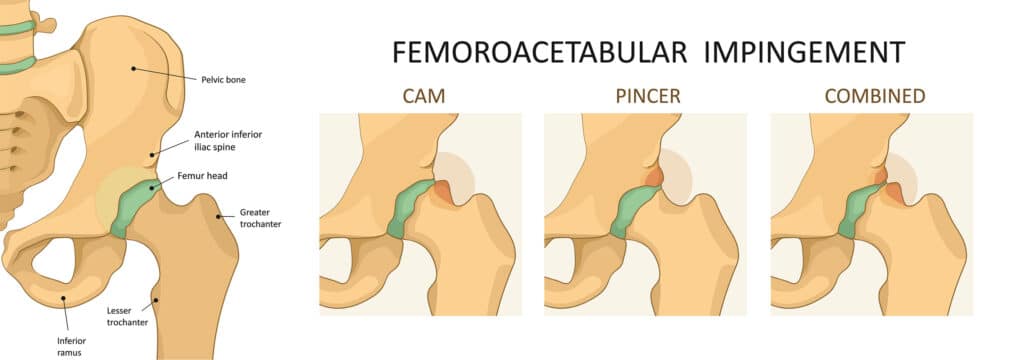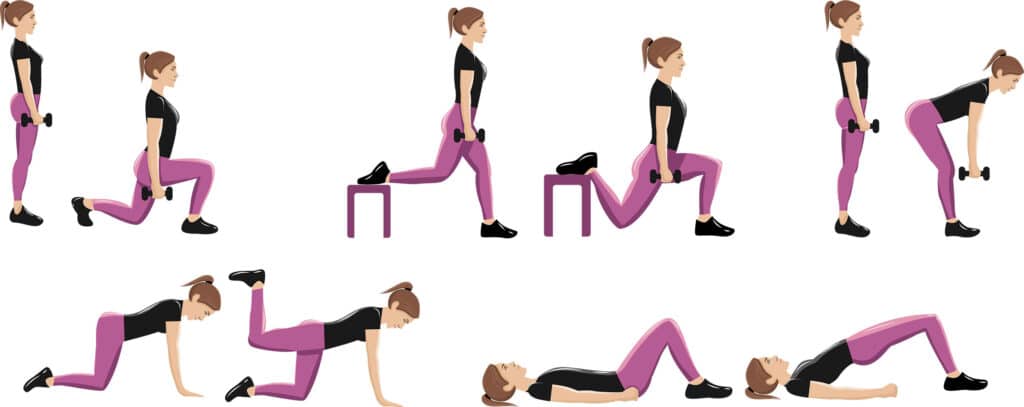Femoroacetabular impingement (FAI), also known as hip impingement, is a blanket term used to describe conditions in which the ball and socket of the hip joint don’t fit together properly, causing discomfort and stiffness in the hip and leg. Hip impingement can be uncomfortable, but luckily, it doesn’t often require surgery. Instead, hip impingement exercises are often used to help reduce pain and increase hip mobility.
What Causes Hip Impingement?
 It’s easy to assume that all hips are alike, but just like we all have different body shapes, our hip bones and hip joints are different, too. Hip impingement can happen for a number of reasons but they’re usually due to one of three main causes.
It’s easy to assume that all hips are alike, but just like we all have different body shapes, our hip bones and hip joints are different, too. Hip impingement can happen for a number of reasons but they’re usually due to one of three main causes.
First, the hip socket, also called the acetabulum, may develop abnormally in children. This can cause the socket to grow too far over the femoral head in the hip joint. This causes the femoral head to scrape against the cartilage in the socket.
Abnormal bumps called cam lesions can also develop on the head-neck junction of the hip ball. These lesions develop during adolescence, particularly in young athletes. Performing some repetitive motions may lead to friction between the ball and the socket, causing the bone to grow and create the cam lesion. Femoral retrotorsion, an abnormal twist in the femur, can also lead to hip impingement.
Finally, hip impingement can also develop in athletes whose hips experience repeated impact. A study at the University of Utah found that football players have over a 75% chance of suffering from irregular hip shapes, potentially as a result of repeated impact and injury.
Symptoms of Hip Impingement
Many people with hip impingement don’t realize it for years. Typically, hip pain doesn’t occur until the damage worsens over time. The most common symptom is pain in the groin area. However, pain may not be present at all in the early stages of hip impingement, or you may think it’s caused by other issues.
Hip impingement pain will usually be noticeable while walking, running, or performing other exercises that flex the hip. Occasionally, a popping or clicking in the front of the hip can be felt or heard. Pain may also radiate from the hip into the thigh, lower back, or buttocks.
Over time, impingement of the hip may tear the ring of cartilage surrounding the hip socket, causing hip pain. Hip impingement may also damage the cartilage that covers the ends of the bones that make up the hip joint. This can wear down the cartilage over time, eventually resulting in a condition known as hip osteoarthritis. Osteoarthritis can cause chronic hip pain, stiffness, and loss of flexibility.
If nothing is done to correct severe hip impingement, these conditions likely will continue to worsen. As they do, hip discomfort, pain, and other symptoms increase. However, preventative care and hip impingement exercises can help prevent or slow deterioration and improve function of the joint.
Useful Hip Impingement Exercises


Hip Flexor Stretches
Hip impingement can cause significant tenderness and weakness in the hip flexors, the muscles responsible for standing and walking. This can cause difficulty walking or standing up. Fortunately, hip impingement exercises can reduce these symptoms by regularly stretching the hip flexors. The most common stretch is outlined below:
- Place your affected knee on the floor, leaning on it while keeping the other foot flat on the ground.
- Slowly stretch your body forward while straightening your back and holding your chest high.
- Flex the muscles in your abdomen by drawing them in, toward the spine.
- Contract your gluteal muscles, holding this stretch for 15 to 30 seconds.
Bridges
Since hip impingement can weaken the muscles in your lower back, strengthening them helps to keep the hip stable. Here’s how you do a bridge exercise:
- Lie on your back, keeping your feet on the floor with your knees bent.
- Tighten your abdominal muscles.
- Raise your hips off the floor, aligned with your knees and shoulders.
- Hold for three deep breaths, put your hips down and repeat five to ten times.
Piriformis Stretches
The piriformis muscle is a flat, band-like muscle located in the buttocks near the top of the hip joint. It stabilizes the hip joint and lifts and rotates the thigh away from the body, so stretching it out is essential for improving hip mobility and reducing pain.
- Lie on your back with your feet flat on the bed and your knees bent.
- Place one of the ankles to rest above your bent knee, grab the thigh of the leg that’s on the floor and pull towards your chest. Go as deep as you feel comfortable.
- Hold the stretch for 20-30 seconds and repeat three times. Repeat on the other side.
Groin Stretches
Hip impingement often triggers tightness in the inner thigh and groin. As a result, stretching the groin muscles or hip adductors can help relieve discomfort and improve mobility. The seated butterfly stretch is an easy hip impingement exercise you can do to help stretch the muscles out.
- Sit on the floor with your back straight and with the soles of your feet pressing into each other.
- Root down into your seat. Tuck your chin, inhale, and on an exhale, allow your knees to fall towards the ground. If it feels too tight, push your feet forward and if you want a deeper stretch, get them close to your body.
- Feel the stretch and hold the pose for 20-30 seconds. Release and repeat three to four times or as many as feels comfortable.
When performing these stretches, it’s important to take it easy and not cause damage through overuse or improper exercise. If you feel pain as a result of any of these stretches, avoid it and speak to your doctor about better alternatives.
Hip Impingement Exercises to Avoid
Before you hit the gym for an intense workout, it’s important to remember that not all exercises or stretches are suited for patients with hip impingement. As a general rule, any exercise which causes the knee to move above the hip should be modified or not performed. Additionally, exercises that involve heavy weights or repeated impacts on the hip joint can cause pain or more damage. These include:
- Deep squats (especially variations like sumo squats)
- High knees
- Lunges
- Leg press
- Deadlifts
- High box jumps
- Rowing on an ergometer
- Plyometrics such as bounding and squat-jacks
In general, any exercise that causes hip pain should be avoided. These hip impingement exercises are often useful for reducing the symptoms of hip impingement, but every individual’s case is unique. If your hip pain intensifies over time or is causing difficulty in daily activities, it’s important to talk to your doctor or physical therapist about what is causing the pain and how you can avoid it.
Edited by Courtney Smith
What Hip Impingement Exercises Help You?
Let us know in the comments below!
What Questions Do You Have About Hip Impingement?
Email us with suggestions for future articles at info@painresource.com
Join the Pain Resource Community
Did you know Pain Resource has different groups for different conditions? Connect with others who share the same condition as you here.





dAbout a month ago I may have pulled a tendon or ligament when swimming doing a scissor type kick. Since then, I have experienced serious
pain in my right groin area. I am interested in this site.
I always wanted to know the best exercises for the hips. Thanks for this valuable information.